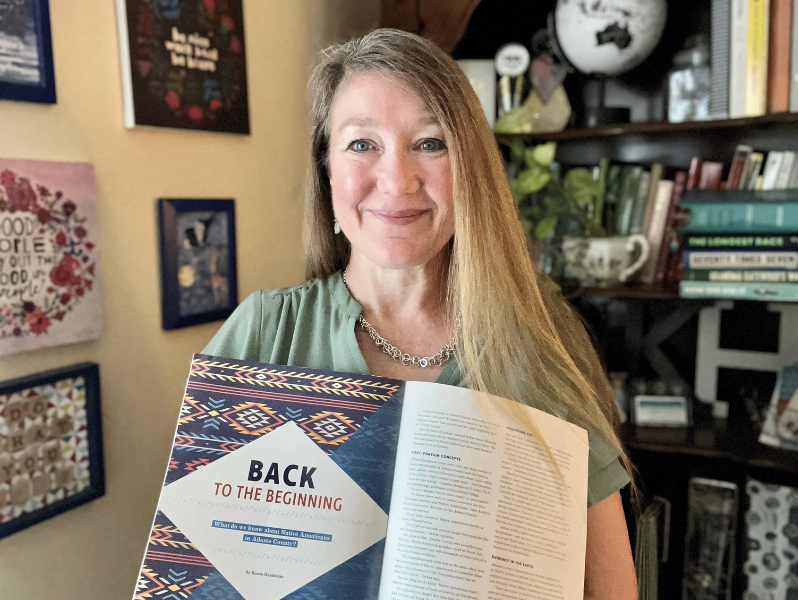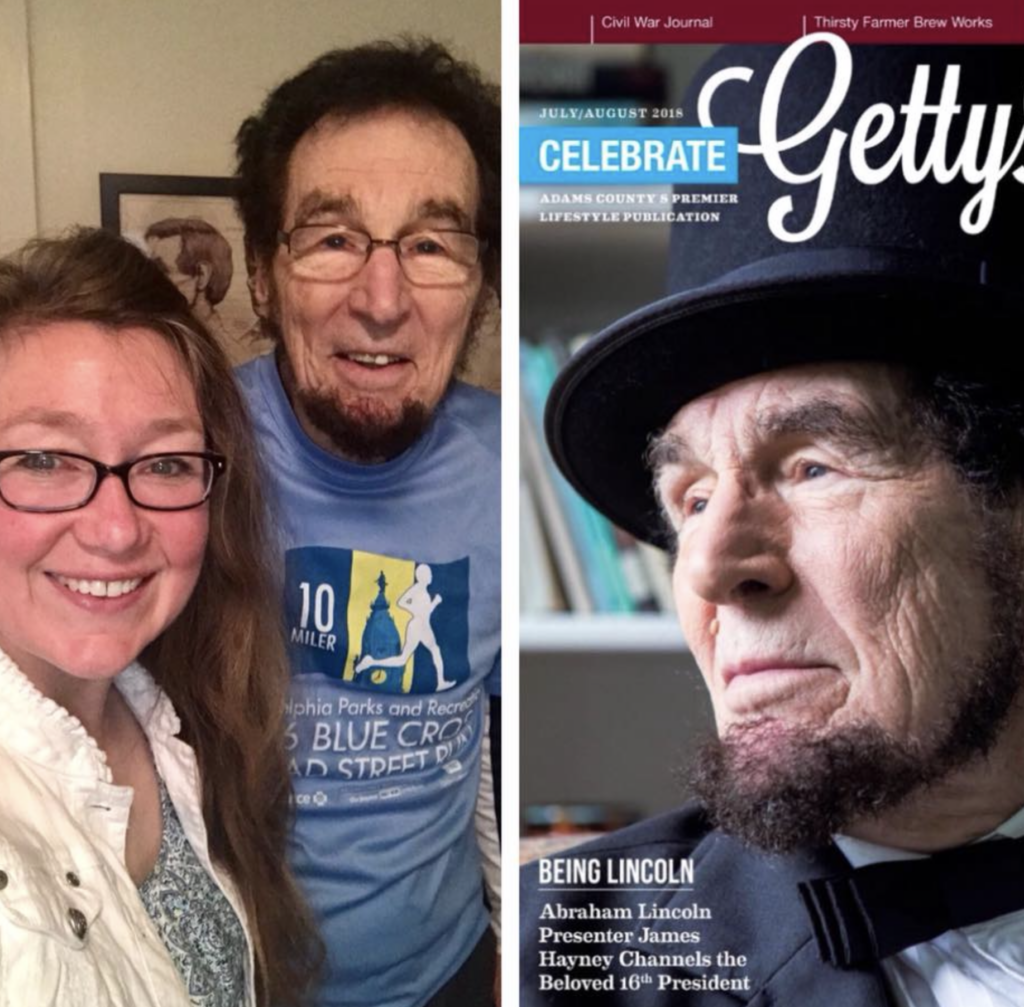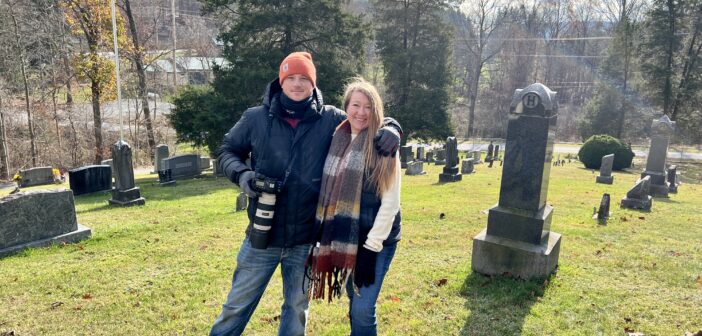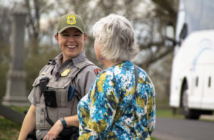This is my 100th story for Celebrate Gettysburg—but like the previous 99, it’s not really my story. It’s yours.
By Karen Hendricks
Journalists aren’t supposed to be “in” stories. We’re observing and asking questions, a bit like digging for hidden treasure. If we’re lucky, we strike gold when those answers are nuggets of wisdom, rich with details, insights and truth.
I consider myself lucky—privileged, even—to have struck gold a few times over the years. But stories don’t have the chance to shine unless they’re shared. I also consider myself lucky—blessed, even—to have had the opportunity to write for what I consider to be one of the greatest American community magazines, Celebrate Gettysburg, for more than 10 years.


Yet, this might be the most difficult story I’ve ever written, because here I am, “in” the story, where I’m not really supposed to be. But I’m deeply honored, humbled and grateful to offer my reflections on 100 stories. Actually, as I write these words, this is my 100th story, so my reflections are on the past 99. (As a life-long journalist, I can be sincere to a fault.)
In magazine journalism, this little paragraph right here should give you a little summary, as well as a little hook, about where I’m going with the story. So here goes. As I sift through a decade of magazines, and the stories and memories come back to me, there is one common thread: The fact that I have written and published 100 stories isn’t so much a testament to my skills, as it is to the warm, generous spirit of people who simply love living in, visiting and sharing stories about Gettysburg.
From Barns and Battlefields,to Trees, Even Tears
Every time I drive past a barn, I think of Curt Musselman. Years ago, I was writing a story about historic barns in Adams County, and Curt was—and still is—involved in the nonprofit Historic Gettysburg Adams County’s barn preservation program. Over cups of coffee at Lincoln Diner, he flipped through photos and architectural drawings and taught me how to evaluate the characteristics of historic Pennsylvania bank barns. Then we went out in the field. Literally. Curt served as my tour guide to the best barns in all of Adams County—from stone foundations to soaring rafters—so that I could write and share what I gleaned with you.
The search for “the perfect Christmas tree” every holiday season reminds me of Michael Breighner of Gettysburg Tree Farm. He opened my eyes to the gorgeous variety within the term “evergreen.” There is indeed life beyond the Douglas fir. There are dark blue-green Canaan fir and Normandy fir, and the rare powder blue, almost aqua Swiss strain of concolor fir. His story is now an evergreen story that lives on, in saved magazines—as many of our subscribers and readers do—and on Celebrate Gettysburg’s website.
I always say I learn something new with every story I cover, and hopefully that means you, our readers, do too. Information and truth, the heart of a story, is the heart of good journalism.
But some of the most memorable stories convey emotion aside facts. I know if I’m moved by someone’s story, then I have a responsibility and a challenge, to share that with you as well. Emotion can inspire readers to take action—actual physical actions or internal thoughts. But the most compelling stories touch and move our hearts.
One of those stories, for me, was Dody Tome-Kern’s. I think of her every time I head north on U.S. Route 15, just over the Adams County line, into Franklin Township, York County. Her husband—and high school sweetheart—Officer David Tome of Northern York County Regional Police lost his life on that stretch of the highway. As he reconstructed a fatal crash, trying to put together the pieces of another family’s tragedy, he was struck and killed by a distracted driver. As Dody bravely shared her story with me, recalled the heartache, relived the senselessness, she also shared the rebuilding of her life, the rediscovery of joy and love—and it was one of the few times that I cried, right along with the person I was interviewing. She even handed me tissues.
I truly believe every person has a story, and every person’s story has value. Telling their stories has undoubtedly made me a better person. Journalism shines within our democracy when it gives voice to the voiceless and brings stories to light. Then it collectively makes us a better community.
Scott Hancock comes to mind. I spent a summer afternoon with Scott, traversing Gettysburg National Military Park—specifically Confederate Avenue and its monuments. He described the scene on July 4, 2020, as demonstrators—militia men armed with assault rifles—came over a hill, closer and closer. Scott, a history professor, was armed with poster boards. He had handwritten facts about Confederate monuments, about the real cause of the Civil War. Slavery. His voice didn’t want to erase history, but to add to it, for a fuller, more complete story of American history. It was my honor to amplify his voice and bring “His Story, History” to light.
I grew up with a deep reverence for our nation’s Revolutionary War history in the Valley Forge area. With that foundation, moving to Gettysburg with my husband in 1992 extended my understanding and appreciation for American history through its Civil War era. I also told people jokingly that I only lived in towns with National Parks.
All joking aside, writing about history for a Gettysburg magazine is one hell of a responsibility. This is where America’s fate as a nation was decided in 1863. As Scott Hancock’s story bore witness, history is still very much alive today—and intertwined with Adams County’s livelihood. I could not be more honored to capture stories I consider vital to our greater American story.
When I arrived at Abraham Lincoln presenter James Hayney’s Camp Hill home to interview him, he warmly welcomed me—not wearing a top hat or Lincoln’s long black coat—but wearing a T-shirt from Philadelphia’s Broad Street Run. We actually began our conversation, quite unexpectedly, chatting about running. That set a friendly foundation, from which we talked about the legacy of Lincoln.

Interviewees, like James, are usually meeting me for the first time. It’s my job and challenge to establish an immediate rapport and trust. After all, I’m asking them for very personal details of their lives within minutes of meeting. I never take that trust for granted—I need to be truthful and accurate in my reporting, because they’re entrusting their thoughts and words to my care. Journalism’s code of ethics is in my DNA.
Entrepreneurs, small business and restaurant owners are some of my favorite people to interview, because they’re in pursuit of the American dream, right here in “the most famous small town in America.” And yet, many Black, brown and minority interviewees express surprise that someone wants to hear and share their stories within the pages of a magazine. How sad—and yet wonderful—is that? I feel a deep responsibility to do their stories justice. Often, it’s the people who think their stories are not worthy of being told whose words ring truer, and linger within us longer.
They often comment, “Thank you for listening—really listening—to me,” or “You really seem to understand.” And I don’t think it’s so much a commentary on my ability to listen, as it is society’s inability to take the time, or have the attention span, to listen. Our society values the quick sound bite, the snarky one-liner. But to truly hear and understand others, you have to be willing to invest more than a minute, more than a paragraph, more than a page.
Curiosity, Connections and Conversations
Time actually feels like it’s standing still while I’m on assignment. I forget about my own life, any challenges that I’m currently facing. Instead, my world revolves around the person I’m interviewing—trying to understand their point of view and putting myself in their shoes. Being truly curious.
Having a sense of wonder. Staying open-minded. Showing empathy. Getting lost in their story.
Because at the end of the day, my job as a journalist boils down to one thing: asking the right questions. The story, my material, is only as good as the questions I ask. It’s walking across the battlefield with Scott Hancock and asking if he feared for his life—ironically on that 4th of July, Independence Day—and ultimately, what he wants people to know about the root cause of the Civil War—because America has never completely healed from her racial wounds. Journalism is also focused on bringing stories and issues to light.
Being a journalist is not a 9-to-5 job. It means molding my calendar around whatever is best for the story.
That means taking a sunrise yoga class with Alli Crowell (for last issue’s story) as she builds a small business, along with her life, following traumatic brain injuries. It means meeting up with Uncle Moe’s Soul Food, street-side, mid-day, to describe the choreography of a finely-tuned food truck operation. Sometimes it means zooming across the globe and time zones, via a Zoom interview with Gettysburg College’s Dr. Benjamin Luley because he’s on an archeological dig in France—but he’s the exact expert who can explain what we know about Native Americans in Adams County.
I approach each story like a puzzle. Interviews and conversations are rarely linear. Instead, it’s my job to put the pieces of each story together, cohesively, revealing one detail at a time, one nugget of wisdom at a time, so that every sentence and paragraph builds upon the one before. By the end of the story, hopefully you have a full, true picture. Sometimes it’s fun to place a cherry on the top of the story, with the last sentence or paragraph satisfyingly putting the last detail into place.
Sharing Kudos
My contribution to each story is black and white—the text, words, sentences and paragraphs on the page. I imagine painting pictures in readers’ minds with those words. But let’s be honest—it’s probably the actual photography or layout that catches your eye and draw you into an article.
And for that, I’m thankful to Celebrate Gettysburg’s founder, owner and creative director Jessica Dean for her beautiful eye and style. Many of the stories I’ve covered over the years began as her ideas and visions. She has a kind, generous and caring community spirit that I believe echoes across every page. Every magazine is like a gift she is giving back to her native Gettysburg and Adams County for shaping her into who she is. She is a beautiful soul, inside and out.
I never would have written one story, let alone 100, if it wasn’t for Michael Vyskocil. He was Celebrate Gettysburg’s editor back in 2013, when I asked if he’d consider adding me to the ranks of his freelance writers. Even though I had worked in newspaper, television, radio and public relations—all involving writing—I had never written one magazine article. Thankfully, he said yes. Looking back, it was a pivotal moment in my career and I could not be more grateful for his early guidance. His career in magazines evolved as did mine, and I was grateful to write for him at additional publications, including Baltimore Style and parenting magazine Philly MetroKids.
Editor Krista Scarlett took me under her wing as well, always sharpening my stories. I learned from her expert edits and kind, thoughtful feedback. Michael and Krista’s clarifying questions and final edits not only made stories stronger, but I believe they made me a better writer.
I may have written 100 stories, but our photographers have taken thousands of photos. I’m especially grateful to Casey Martin. He not only accompanies me on every foodie assignment, but he’s lugged photography equipment into some unusual places in pursuit of good stories with the pictures to prove it. A frigid Fairfield hillside, where we met Lisa Rawlings, scrubbing and restoring gravestones. Into the yellow safe house operated by Survivors, Inc. to absorb the weight of our community’s domestic violence and human trafficking survivors’ stories.
Writers are only as good as the company they keep, and I’m honored to have bylines in the same magazine as many fellow journalists—notably Alex Hayes, former editor of the Gettysburg Times, and Lisa Gregory, published in the Washington Post and Baltimore Sun.
I also want to thank you, dear readers and subscribers, as well as advertisers. Journalists, like scientists, medical professionals and many other fields where experts—in my opinion—should be trusted to be experts, are often under attack. Many print publications are sadly shutting down. But the fact that Celebrate Gettysburg continues to be a vibrant, vital publication serving our Adams County community, including beloved visitors, is a ray of hope for society’s future. Journalism is essential to American democracy.
Gettysburg was recently named “the most welcoming city in the United States” by Booking.com. No surprise here. It’s because of the people, the community.
Gettysburg was the turning point of the Civil War, the pivotal place that continues to define America’s fate as a nation. I think living in Gettysburg inspires its residents to become catalysts for change, to live lives of purpose. How could their stories be anything but insightful, uplifting and inspiring?
When you live here, and see the hallowed grounds of the battlefield every day, you’re surrounded by bittersweet beauty, reminders of life and death, victory and defeat. American icons like Abraham Lincoln. It’s a place of poignant passion. And that seeps into us as a people.
I’m overwhelmed with gratitude to all those who shared their stories with me over the years. This milestone of 100 stories isn’t about me—it’s about them. I just happened to be the storyteller with access to a treasure trove of people—the residents of Gettysburg and Adams County.




